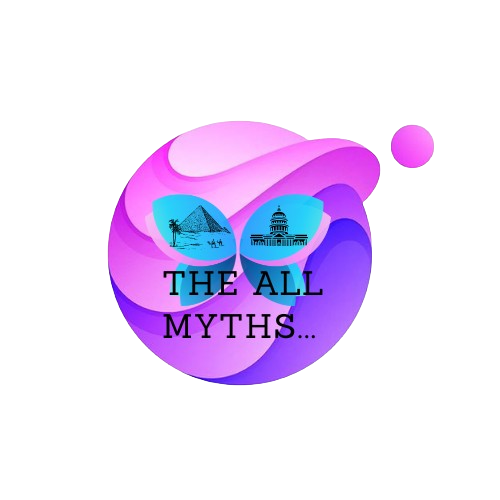Demons
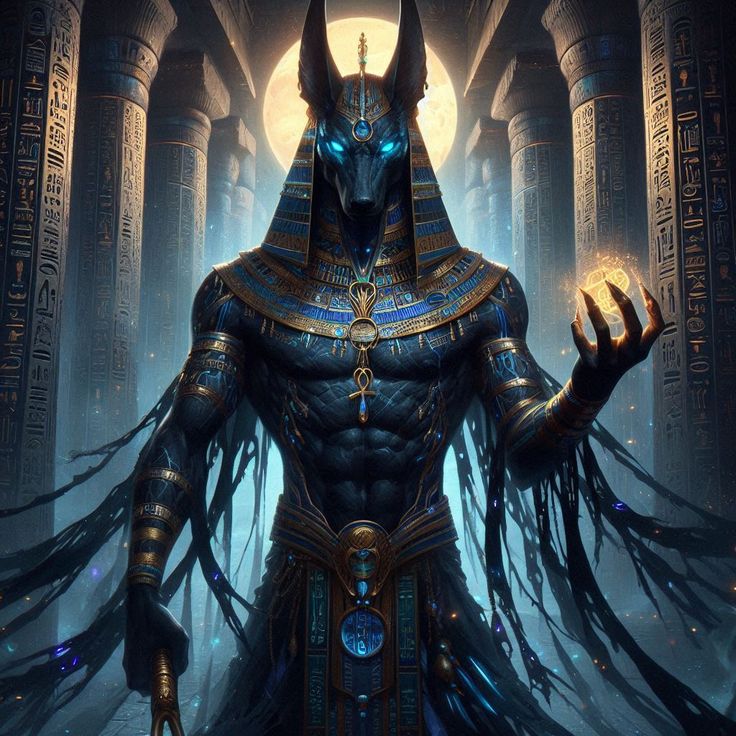
Demons (called “daimons” or spirits) in Egyptian belief were not always purely evil. Some were protective, guarding sacred places or helping the dead in the afterlife. Others were malevolent, causing illness, nightmares, or punishing sinners. Famous Demons/Spirits: Admit (The Devoured) – Part crocodile, lion, and hippo. Ate the hearts of the unworthy in the afterlife. Apophis (Apex) – Giant serpent of chaos, enemy of Ra. Tried to swallow the sun during its nightly journey. Bes – Dwarf demon/god, protector of households, mothers, and children. Though scary-looking, he was friendly to humans. Muster – Guardians of the dead, often shown as jackal-headed demons. Series (sometimes goddess, sometimes spirit) – Associated with scorpions, protector against venom. Forty-Two Judges – Spirits in the Hall of Ma’at, testing the soul of the deceased with questions.
Nut,Sut and Geb
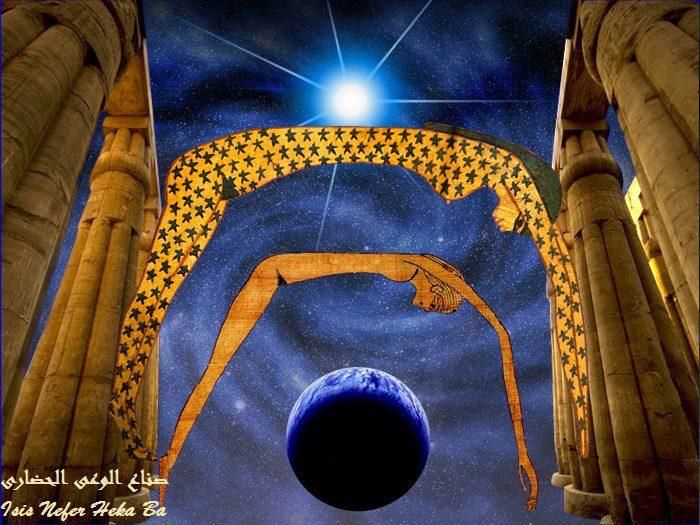
Nut (Sky Goddess) Role: Goddess of the sky, stars, and heavens. Depiction: A woman arched over the earth, her body covered in stars. Sometimes painted blue. Myth: She was the daughter of the air god SHU and the moisture goddess Tent. Her brother and husband were Get (Earth god). Together they were separated by Shu (air), creating space between sky and earth. Nut gave birth to Osiris, Isis, Set, and Depths, the most important gods of Egypt. Belief: Each night, Not swallowed the sun god Ra, and each morning she gave birth to him again—explaining day and night. Symbolism Represents rebirth, cosmic order, and eternal life. 2. Set (But, Seth) Role: God of chaos, storms, deserts, and violence. Depiction: A man with the head of the mysterious “Set animal” (long snout, square ears, forked tail). Myth: Son of Nut and Geb, brother to Osiris, Isis, and Depths. Famous for killing his brother Osiris out of jealousy, and battling Osiris’s son Horus for the throne of Egypt. Seen as a symbol of disorder but also necessary for balance. In some traditions, Set was also the protector of Ra, fighting the chaos serpent Poufs each night. Symbolism: Represents both destruction and protection, showing Egypt’s belief in balance between order (Ma’at) and chaos (Islet). 3. Get (Earth God) Role: God of the earth, fertility, and crops. Depiction: A man lying on the ground beneath Nut, often with green skin (symbol of fertility). Sometimes with a goose on his head (his sacred animal). Myth: Son of Shu (air) and Tent (moisture). Brother and husband of Nut. Their children: Osiris, Isis, Set, and Depths. Pharaohs were sometimes called “heirs of Get” because he was the first divine king of Egypt. Egyptians said earthquakes were laughs. Symbolism Represents fertility, agriculture, and kingship. Relationship Between Them Nut (Sky) arches above. Get (Earth) lies below. Set (their son) represents chaos, while his siblings (Osiris, Isis, Depths) represent life, order, and protection. Together, they form the core of Egyptian creation mythology.
Amun
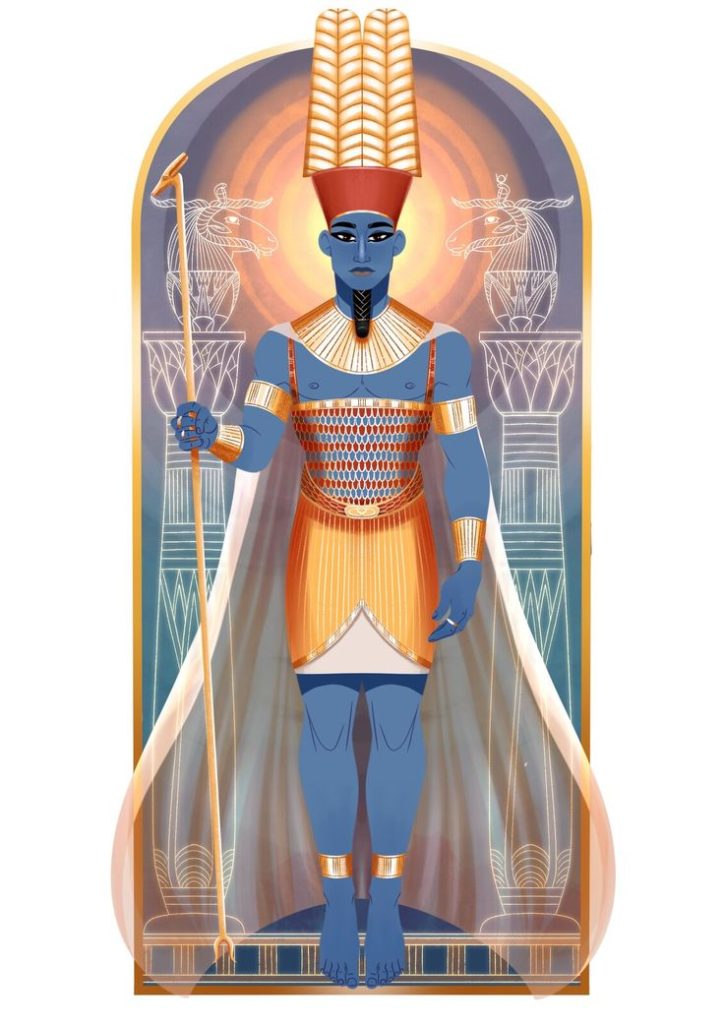
1. Who is Amun? Amun (also spelled Amen, Ammon) means “The Hidden One”. Originally a local Theban god of air and wind, who later rose to become one of the most powerful deities of Egypt. When combined with the sun god Ra, he became Amanda, the supreme creator god and ruler of the universe. 2. Depiction Usually shown as a man wearing a tall crown with two plumes. Sometimes depicted as a ram or with a ram’s head (symbol of fertility and strength). In rare forms, shown as a goose (his sacred animal). 3. Mythology & Beliefs Creation Role: Amun was believed to be invisible, mysterious, and beyond human understanding. He was seen as the hidden force behind creation, present in everything but unseen. Rise to Power: In the Middle Kingdom (around 2000 BCE), Thebes became powerful, and Amun rose with it. By the New Kingdom, Amun was worshiped as king of the gods, often merged with Ra as Amanda. Connection with Pharaohs: Pharaohs called themselves “sons of Amen” to legitimize their rule.4. Symbols Crown with tall double plumes. Ram (strength, fertility). Ankh (life). Scepter (power). 5. Temples & Worship Barney Temple (Thebes) – the largest religious complex in the world, dedicated to Amen. Luxor Temple – also linked to Amun’s worship. During festivals, Amun’s statue was paraded on the Nile in grand ceremonies. 6. Amanda When merged with Ra (sun god), Amun became Amanda:
Anubis
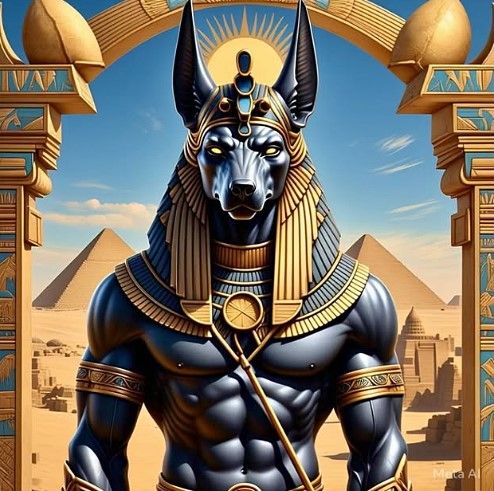
1. Who is Anubis? Egyptian name: Input / ANP. The jackal-headed god of mummification, tombs, and the afterlife. Protector of graves and guide of souls to the underworld. 2. Depiction Usually shown as a man with a black jackal (or dog) head. Black color symbolized death, rebirth, and the fertile soil of the Nile. Sometimes depicted fully as a jackal. 3. Mythology & Role Parentage: In different myths, Anubis is the son of Osiris and Depths (sometimes Isis). Protector of the Dead: He guarded tombs from robbers and evil spirits. Priests wore jackal masks of Anubis duringg rituals. Believed to have embalmed Osiris after Set killed him, making Osiris the first mummy. Weighing of the Heart: In the Hall of Ma’at, Anubis weighed the deceased’s heart against the Feather of Truth (Ma’at). If the heart was lighter, the soul was pure and granted eternal life. If heavier, it was devoured by Ammit, the Demon. 4. Symbols Jackal – linked to cemeteries (jackals often roamed near graves). Scales – used in weighing the heart ceremony. Flail & Scepter – symbols of authority. 5. Temples & Worship Anubis did not have huge temples like Ra or Amen, but he was worshiped in cemeteries and tomb chapels. Priests of Anubis performed embalming rituals. People prayed to him for the protection of their dead relatives. 6. Titles of Anubis “Guardian of the Scales” – for judging the dead. “Lord of the Sacred Land” – protector of cemeteries. “He Who Is Upon His Mountain” – watching over tombs. 7. Anubis in Later Beliefs After Osiris became the main god of the dead, Anubis was seen more as Osiris’s helper. Still, he remained central in funeral rituals and loved by common people.
Brahma
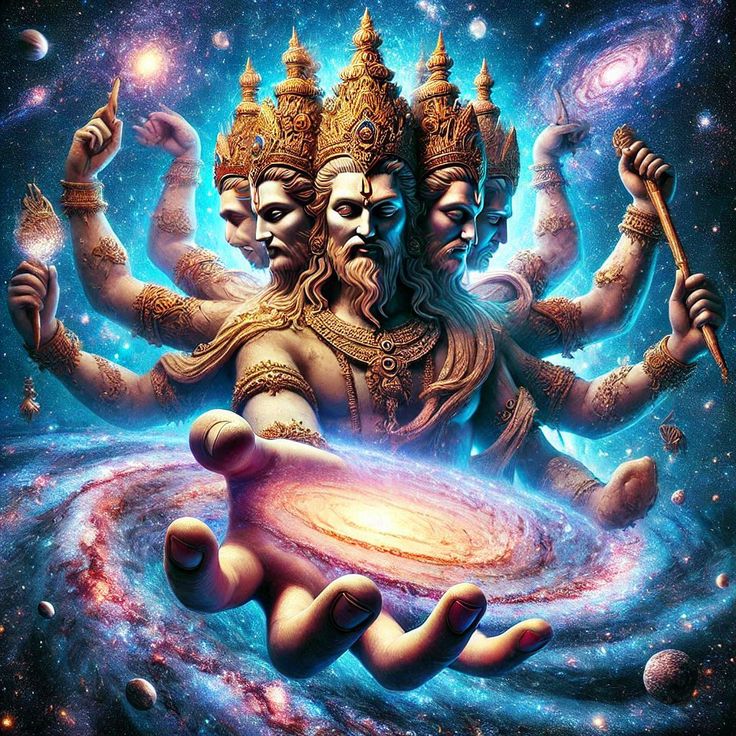
The Story of Lord Brahma – The Creator in Hindu Mythology. In Hinduism, the Trimurti—Brahma, Vishnu, and Shiva—represent the three core aspects of existence: creation, preservation, and destruction. At the heart of this trinity lies Lord Brahma, the creator of the universe, who gave shape to time, space, beings, and knowledge. Though less worshiped today compared to Vishnu and Shiva, Brahma’s story remains central to Hindu philosophy and cosmology. The Birth of Brahma: The origins of Brahma are narrated in different ways across Hindu texts like the Purana’s and the Vedas. The most popular version describes him as emerging from a golden cosmic egg (Hiranyagarbha) that floated in the primordial waters. From this egg, Brahma was born with four heads, each facing one of the four directions, symbolizing his all-seeing nature and mastery of the Vedas. Another version says that Brahma was born from the navel of Lord Vishnu, seated on a lotus flower. From this lotus, he began the work of creation, making him the link between Vishnu’s preservation and Shiva’s transformation. Brahma as the Creator Once born, Brahma took on the role of creating the universe. He began by bringing forth the elements—earth, water, fire, air, and space. Then he created time, heaven, and the cosmic order. He gave life to the first beings, including the Degas (gods), Auras (demons), Rights (sages), and Many (the first man), who would carry forward humanity. To assist him in creation, Brahma gave birth to the seven great sages (Maharishis) and other divine beings. His consort, Sarasota, the goddess of wisdom, music, and knowledge, played a vital role in guiding creation with intellect and learning. The Four Heads of Brahma: One of the most striking features of Lord Brahma is his four heads. Each head is said to recite one of the four Vedas-Rigged, Samaveda, Yajurveda, and Atharva Veda. Together, they represent knowledge, creation, and the eternal truths of existence. Legend says Brahma originally had five heads, but one was burned away by Lord Shiva due to Brahma’s pride. This serves as a reminder that even the creator must remain humble before the eternal cosmic order. Brahma and Saraswati Brahma’s connection with Saraswati is one of the most symbolic aspects of his story. While Brahma represents creation, Saraswati embodies the wisdom and knowledge needed to sustain it. Without her, creation would be meaningless. Together, they form a divine partnership of intellect and creativity. Why Brahma is Rarely Worshiped Unlike Vishnu and Shiva, who have millions of temples dedicated to them, Brahma has very few places of worship. The most famous is the Brahma Temple in Pusher, Rajasthan. According to legend, Brahma performed a Anna (sacrifice) at Pusher, where his wife Sarasota could not arrive on time. To complete the ritual, Brahma married another goddess, Gayatri. When Saraswati arrived and saw this, he cursed Brahma that he would not be worshiped widely on Earth. This is why Brahma’s temples are extremely rare, though his role as the creator remains deeply respected. Symbolism of Lord Brahma Beard & Four Arms: Wisdom, balance, and creation. Lotus Seat: Purity and the unfolding of life. Vedas in Hand: Eternal knowledge. Kamandalu (water pot): The source of life. Brahma represents the power of beginnings, reminding us that everything—thoughts, actions, and creations—has a divine origin.
Vishnu
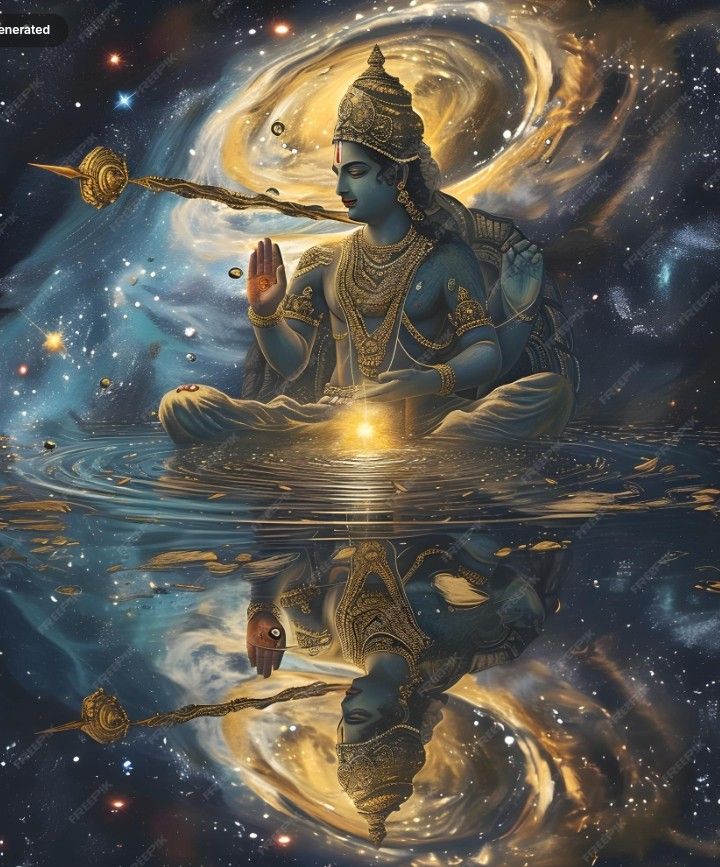
1. Who is Vishnu? Vishnu is the preserver and protector in the Hindu trinity (Trimurti): Brahma – Creator Vishnu – Preserver Shiva – Destroyer. His role is to maintain cosmic order (dharma) and protect the universe from chaos. 2. Depiction Usually shown with: Blue skin (symbol of infinity and cosmic nature). Four arms, each holding a sacred object: Shank ha (conch) – sound of creation (Om). Chakra (discussion) – weapon to destroy evil. Gaza (mace) – power and strength. Padma (lotus) – purity and divine truth. Often shown resting on the serpent Ananta (Shes ha Nāga), floating on the cosmic ocean. His consort is Lakshmi, goddess of wealth and prosperity. 3. Mythology & Beliefs Protector of Dharma: Whenever evil rises and dharma (righteousness) declines, Vishnu descends to earth in different forms (avatars). Avatars (Dashavatara): Vishnu’s ten incarnations, appearing in different ages to save the world. Mats ya (fish) – saved the Vedas during a great flood. Burma (tortoise) – supported Mount Mandala during the breaking of the ocean. Var aha (boar) – rescued Earth from the demon Hiranyaksha. Narasimha (half-man, half-lion) – destroyed the demon Hiranyakashipu. Vamana (dwarf) – humbled the demon-king Bali. Parashurama (warrior with an ax) – destroyed corrupt kings. Rama (hero of Ramayana) – defeated Havana. Krishna (hero of Mahabharata) – divine guide, speaker of the Bhagavad Gita. Buddha (sometimes included) – taught compassion and non-violence. Kalki (future avatar) – will appear at the end of Kali Yoga to destroy evil. 4. Symbols: Shank ha (conch) – divine sound, creation. Chakra (Darshan) – destroys evil. Garuda (eagle) – Vishnu’s vehicle, symbol of speed and strength. Serpent Ananta (Shesha Naga) – eternity, cosmic balance. 5. Temples & Worship: Vishnu is widely worshiped across India, especially by Vaishnavites. Major Vishnu temples: Tirupati Balaji (Andhra Pradesh) Marinate (Uttarakhand) Ranganathaswamy Temple (Srinagar) Padmanabhaswamy Temple (Kerala) Festivals: Vaikuntha Ekadashi, Krishna Janmashtami, Rama Navami, Diwali (in some regions). 6. Titles of Vishnu Narayana – One who rests in the waters. Hari – The remover of sins. Jagannath – Lord of the universe. Madhava – Consort of Lakshmi. 7. Vishnu’s Role in Trimurti Brahma creates, Vishnu preserves, Shiva destroys. Vishnu ensures the balance of the universe between creation and destruction.
Mahadeva(shiva)
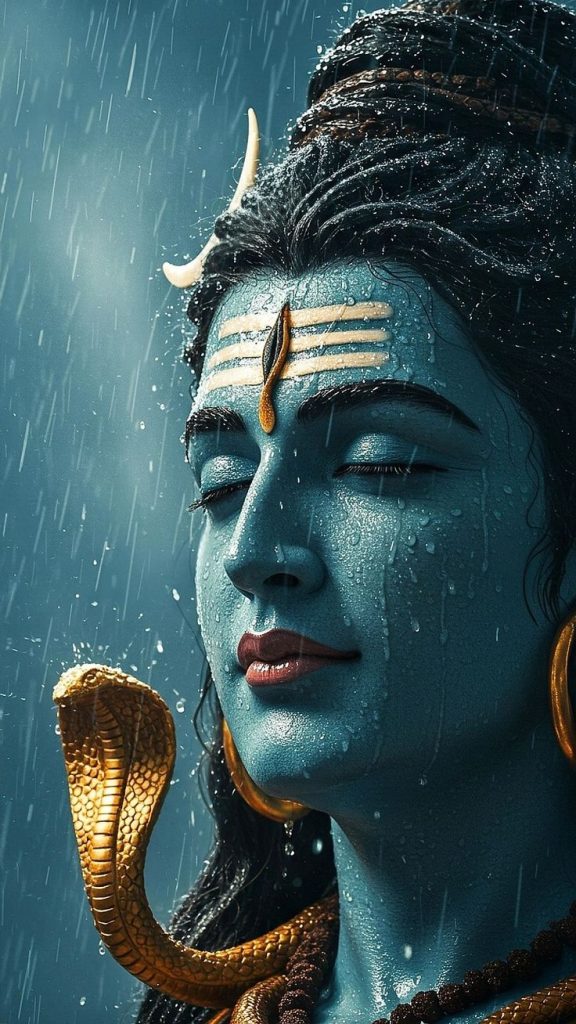
1. Who is Shiva? Shiva (also called MahaRERA) is one of the three main gods of the Hindu Trimurti: Brahma – Creator Vishnu – Preserver Shiva – Destroyer / Transformer. He is the source of destruction, regeneration, and ultimate liberation, clearing the way for new creation. In many traditions, he is also regarded as the Supreme Being (Paramashiva) beyond creation. 2. Depiction Usually shown as: Ash-smeared ascetic seated in meditation on Mount Kai lash. Wearing tiger skin and rudraksha beads. Third eye on the forehead – symbol of higher wisdom and inner vision. Crescent moon on his matted hair, with the river Gang flowing from it. Holding a trident (Trisha) and a small drum (Amaru). Often accompanied by Nandi, the sacred bull. Sometimes worshiped in the abstract form of the Shiva Ling am (symbol of infinite energy). 3. Mythology & Stories Cosmic Dance (Natural): Shiva performs the Tanaka, a dance that represents creation, preservation, and destruction of the universe. Marriage & Family: Married to Parfait (Shakti). Their sons are Ganesha (remover of obstacles) and Kartikeya (god of war). Churning of the Ocean (Samudra Manthan): When poison (Haleakala) emerged, Shiva drank it to save the world, holding it in his throat, turning it blue — earning the name Neelkanth (Blue-Throated). Ardhanarishvara: A form combining Shiva and Parfait in one body, symbolizing the unity of masculine and feminine energies. 4. Philosophy & Attributes Represents the cycle of destruction → renewal. Embodies detachment, meditation, and inner stillness, yet also raw, transformative power. Seen as a patron of yoga, meditation, and arts. Associated with the concept of Moshe (liberation). 5. Symbols: Trisha (trident) – power over creation, preservation, destruction. Damaru (drum) – the rhythm of the cosmos. Serpent around his neck – control over fear and death. Ganga – life-giving river, purifying power. Vibhuti (holy ash) – detachedness and immortality. 6. Temples & Worship: Shiva is worshiped across India and beyond. Major temples: Kedarnath, Somnath, Kashi Vishwanath, Rameshwaram, Amaranth (among the 12 Jyotirlingas). Festivals: Maha Shivaratri – the grand night of Shiva, with fasting and night-long prayers. Caravan month – sacred for Shiva devotees. 7. Forms of Shiva Rudra – fierce, stormy form from the Vedas. MahaRERA – the great, benevolent god. Bereave – terrifying protector. Shankara – auspicious, gentle aspect. Natural – Lord of the Dance. Pashupatinath – Lord of all living beings.
Lakshmi
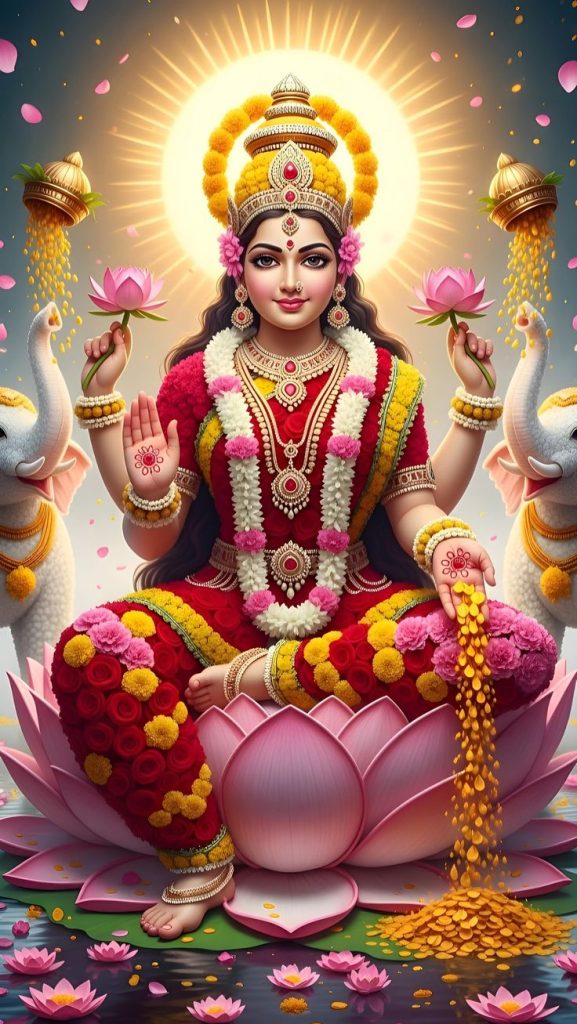
1. Who is Lakshmi? Lakshmi (or Laxmi) is the Hindu goddess of wealth, prosperity, fortune, and beauty. She represents both material abundance and spiritual well-being. She is the consort of Lord Vishnu, accompanying him in all his incarnations (Rama, Krishna, etc.). 2. Depiction Usually shown as: A beautiful woman with golden complexion, dressed in red or gold garments. Standing or seated on a fully bloomed lotus. Gold coins flowing from one of her hands. Two or four hands, holding: Lotus flowers (purity, beauty, fertility). Pot of gold or coins (prosperity). Gesture of blessing (Adhara Audra). Sometimes shown with elephants pouring water over her — symbol of royal power and fertility. 3. Mythology & Stories Origin: Lakshmi emerged during the Samudra Manthan (Churning of the Ocean of Milk) by gods and demons to obtain Amrita (nectar of immortality). She rose from the ocean, seated on a lotus, radiating beauty and fortune. Marriage: She chose Lord Vishnu as her eternal partner and accompanies him in all his avatars: As Site with Rama. As Rukmini with Krishna. Grants wealth, success, fertility, and good luck, but only to those who work hard and live ethically. 4. Symbols Lotus – purity and spiritual growth amid material life. Gold coins – wealth and generosity. Elephants with water – power, fertility, royal blessings. Red or pink garments – energy, love, and prosperity. 5. Forms of Lakshmi (Asha-Lakshmi) Lakshmi is worshiped in eight forms, known as the Asha-Lakshmi, each representing a type of wealth: Adi Lakshmi – Primeval mother. Diana Lakshmi – Abundance of food and agriculture. Dairy (Veera) Lakshmi – Courage and strength. Gaja Lakshmi – Power, royal grace. Santana Lakshmi – Fertility and progeny. Vijaya Lakshmi – Victory and success. Vidya Lakshmi – Knowledge and education. Diana Lakshmi – Material riches. 6. Worship and Festivals worshiped especially during Diwali — people light lamps to invite her blessings for wealth and happiness. Varalakshmi Vratam (South India) is another major festival devoted to her. Fridays are considered auspicious for her worship. Devotees keep homes clean and light lamps, as cleanliness and light symbolize inviting her grace. 7. Temples Famous Lakshmi temples in India: Mahalakshmi Temple (Kolhapur, Maharashtra) Padmavathi Temple (Tiruchanur, Andhra Pradesh) Ashtalakshmi Temple (Chennai, Tamil Nadu) Mahalakshmi Temple (Mumbai) 8. Philosophy & Significance Lakshmi’s blessings are not only about money, but also about: Harmony in relationships Good health Knowledge and inner peace She rewards cleanliness, devotion, honesty, and hard work, while leaving places where there is laziness, quarrels, or impurity.
